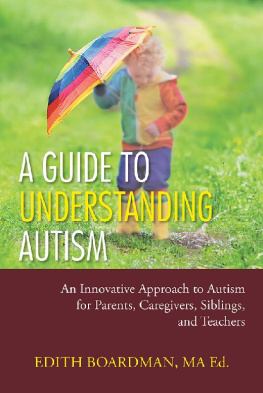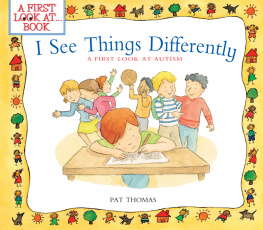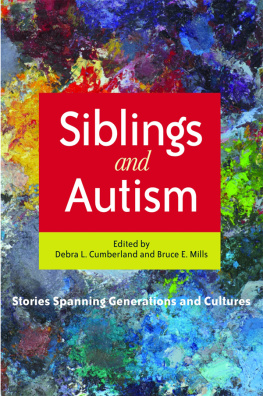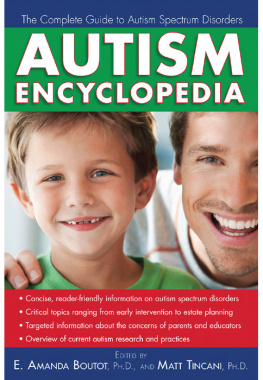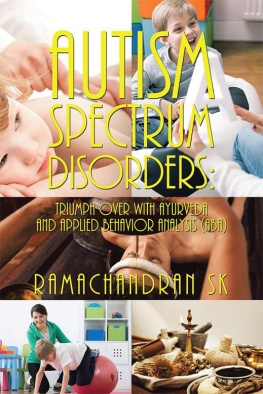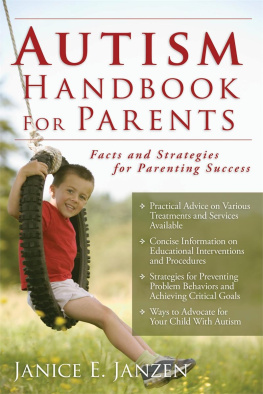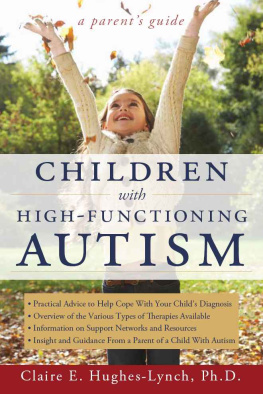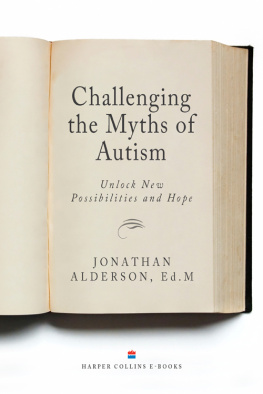A Guide to Understanding Autism
An Innovative Approach to Autism for Parents, Caregivers, Siblings, and Teachers
EDITH BOARDMAN, MA Ed.

AuthorHouse
1663 Liberty Drive
Bloomington, IN 47403
www.authorhouse.com
Phone: 1 (800) 839-8640
2019 Edith Boardman, MA Ed. All rights reserved.
No part of this book may be reproduced, stored in a retrieval system, or transmitted by any means without the written permission of the author.
Published by AuthorHouse 11/22/2019
ISBN: 978-1-7283-3544-5 (sc)
ISBN: 978-1-7283-3543-8 (e)
Any people depicted in stock imagery provided by Getty Images are models,
and such images are being used for illustrative purposes only.
Certain stock imagery Getty Images.
Because of the dynamic nature of the Internet, any web addresses or links contained in this book may have changed since publication and may no longer be valid. The views expressed in this work are solely those of the author and do not necessarily reflect the views of the publisher, and the publisher hereby disclaims any responsibility for them.
Contents

D uring the past decades, working with children, who have autism; I have found misconceptions still abounds. It is not certain why some people are wired cognitively different, and appear to behave differently. But neither is it certain why suddenly, out of nowhere, a rainbow appears. The fact remains that, these events occur, and like the rainbow we must embrace the differences in human physiology. Working with children who have autism have not always been easy neither has it been difficult. I have felt joy in the little progress made. I have also expressed frustration at my inability to fully understand the condition, and thereby have the ability to effect change. Here lies the crux of the matter, the desire to gain information in order to manipulate change, in effect, to change a person to become like everyone else? No one can do that. Moreover, it is the wrong approach, best to work with what is now! Seek not to improve on creation or to reinvent a new person. God never make mistakes, autism is not a mistake. Autism is constant; autism is predictable; autism is unvarying in its behavior, its rigidity, and its resistance to change.
This book is useful for those who work with the autism population, parents, inclusion teachers, special education teachers, siblings, extended families and anyone with a calling to educated children with autism. A calling is a desire to work in a field without necessarily understanding why, but rather be able to make a difference. Having the patience required and willing to learn the patience needed, to understand better how to interact with a person with autism; and enable him to learn to live a healthier lifestyle. This book will explain and empower those who work with the autism population, allow them to provide the necessary daily practices, which will replace inappropriate behavior with appropriate skills required for effective daily functioning.
Often when first confronted with autism most parents are at a loss to find all the information they need in one place. Most of the information garnered in this book is to guide and educate and not for medical expertise. Many of the tips in the book can be modified to fit individuals, and should be used as a starting point to help in the understanding of autism. Power to empower can be misunderstood; the character of stubbornness in autism can be viewed as a shield to prevent total misuse of dependency associated with autism. Hopefully, readers will learn that nothing and no one is an emblem of perfection and like the rainbow, all humans are made up of different hues.

P eople with autism have difficulties navigating their families and their communities. It is not just a question of normality or abnormality but rather about the likes and dislikes of an individual. How these likes and dislikes can influence their ability to function daily. Learning new skills will increase their ability to live in a society as prescribed by their surroundings; and not to remain lost in their inability to function in a noisy world. The beginning is the best place to start, choose your battles, and celebrate your victories, however minute when your child attempts a new activity. Understand that it will be a long haul; be prepared to roll up your sleeves and dig in.
Autism is not a disease, so there is no cure for autism. There can only be a cure if there is an illness. Treating autism primarily focuses on symptom management; and will help the person with autism live a productive lifestyle.
Be advised care givers, that there is a strand, a filament, a nerve center in the human temperament that gets burnt out, and can completely exhaust itself both physically and emotionally. To be a caregiver for a child is different to caring for a pre-teen, a teenager or an adult, especially when giving only flows in one direction. Autism does not understand the reciprocal form of interaction. Autism will only give what it learns how to give. If you find yourself feeling in need of emotional interaction, best remove yourself from the situation, replenish your soul and your spirit and begin again; life is for-giving.
Support groups, families in the same situation: starting a group and sharing resources through blogs can be a great outlet as well as to help others. Many groups and centers started as a one man band. Find sources to replenish the energy used up in giving. You will discover that autism does not give in the manner we expect, but rather receive in the manner we know; the usual method of interaction is a deficit and therefore not available to the autism person.
No one can change a child to become the blueprint of their imagination, even those who are experiencing autism, cannot change themselves to become like everyone else. It is not for us to question the reasons why me, but rather to know that it is what it is - an ongoing search to discover the best way to empower, and enable every individual with autism to live their best existence. I have discovered that when patience exceeds expectations breakthrough occur, a glimmer of hope, joy, and triumph. I continue to believe that with the advancement of science; One day there will be a better understanding of Autism spectrum disorder.
In spite of awareness drives and growing academic progress, great misconception still exists. Many people have never heard of autism despite an increasing number of new diagnoses. Some people view autism as an incurable disease or a viral infection that can contaminate, while others filled with images of a savant, as portrayed by the media, visions of the savant Rain Man movie. It adds to the paranoia, shame, apathy and the desire for secrecy, thereby preventing early intervention. Some parents are unaware of autism or the associated signs. At the extreme end are parents who are embarrassed, ashamed or blame themselves for their childs condition. It is nobodys fault, it is what it is. Desist from blame shame and get on with the work ahead.

A utism is classified as a developmental disability significantly affecting verbal and nonverbal communication and social interaction, generally evident before age three that adversely affects a childs educational performance. Other characteristics often associated with autism are engagement in repetitive activities and stereotyped movements, resistance to environmental change or changes in daily routines, and unusual responses to sensory experiences IDEA 2004.
Next page
